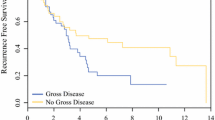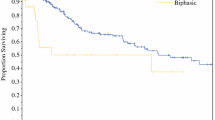Abstract
Background
Improved survival has been reported for diffuse malignant peritoneal mesothelioma (DMPM) treated by surgical cytoreduction and hyperthermic intraperitoneal chemotherapy (HIPEC). The significance of lymph node involvement in this disease is still poorly understood.
Methods
Prospectively collected clinical data on 83 consecutive patients with DMPM undergoing surgical cytoreduction and closed-abdomen HIPEC with cisplatin and doxorubicin were reviewed. Clinically suspicious lymph nodes were submitted to pathological examination. The impact of nodal involvement on survival was assessed by multivariate analysis; 14 clinicopathological control variables were tested.
Results
For the overall series, median follow-up was 52 months (range 1–126 months) and 5-year overall survival (OS) was 49.5%. Lymph nodes were submitted to pathological examination in 38 patients, being positive in 11 and negative in 27. Lymph nodes were not clinically suspicious and not sampled in 45 patients. Iliac (n = 7) and paracolic (n = 2) nodes were the most commonly involved nodes. OS was 18.0% for patients with pathologically positive nodes and 82.5% for those with pathologically negative nodes (P = 0.0024). On multivariate analysis, pathologically negative (versus positive/not assessed) nodes [hazard ratio (HR) = 2.81; 95% confidence interval (CI) = 1.12–7.05; P = 0.027], epithelial subtype (HR = 2.93; CI = 1.24–6.95; P = 0.015), mitotic count ≤5/50 high-power microscopic fields (HPF) (HR = 5.34; CI = 1.96–14.54; P = 0.001), and completeness of cytoreduction (HR = 2.06; CI = 1.19–3.56; P = 0.001) correlated with increased OS. Positive nodes (versus negative/not assessed) did not significantly correlate with survival.
Conclusion
Pathologically negative nodes (as compared with pathological positive and not assessed), along with pathological and biological features, independently correlated with increased survival following comprehensive treatment. This suggests the need for careful node sampling when performing surgical cytoreduction for DMPM patients.



Similar content being viewed by others
References
Markman M, Kelsen D. Efficacy of cisplatin-based intraperitoneal chemotherapy as treatment of malignant peritoneal mesothelioma. J Cancer Res Clin Oncol. 1992;118:547–50.
Neumann V, Muller KM, Fischer M. Peritoneal mesothelioma: incidence and aetiology. Pathologe. 1999;20:169–76.
Eltabbakh GH, Piver MS, Hempling RE, Recio FO, Intengen ME. Clinical picture, response to therapy, and survival of women with diffuse malignant peritoneal mesothelioma. J Surg Oncol. 1999;70:6–12.
Loggie BW, Fleming RA, McQuellon RP Russel GB, Levine EA. Prospective trial for the treatment of malignant peritoneal mesothelioma. Am Surg. 2001;67:999–1003.
Sugarbaker PH, Welch LS, Mohamed F Glehen O. A review of peritoneal mesothelioma at the Washington Cancer Institute. Surg Oncol Clin North Am. 2003;12:605–21.
Feldman AL, Libutti SK, Pingpank JF, et al. Analysis of factors associated with outcome in patients with malignant peritoneal mesothelioma undergoing surgical debulking and intraperitoneal chemotherapy. J Clin Oncol. 2003;21:4560–7.
Brigand C, Monneuse O, Mohamed F, Sayag-Beaujard AC, Isaac S, Gilly FN, et al. Malignant peritoneal mesothelioma treated by cytoreductive surgery and intraperitoneal chemohyperthermia: results of a prospective study. Ann Surg Oncol. 2006;13:405–12.
Deraco M, Nonaka D, Baratti D, et al. Prognostic analysis of clinicopathologic factors in 49 patients with diffuse malignant peritoneal mesothelioma treated with cytoreductive surgery and intraperitoneal hyperthermic perfusion. Ann Surg Oncol. 2006;13:229–37.
Yan TD, Brun EA, Cerruto CA, Haveric N, Chang D, Sugarbaker PH. Prognostic indicators for patients undergoing cytoreductive surgery and perioperative intraperitoneal chemotherapy for diffuse malignant peritoneal mesothelioma. Ann Surg Oncol. 2007;14:41–9.
Elias D, Bedard V, Bouzid T, Duvillard P, Kohneh-Sharhi N, Raynard B, et al. Malignant peritoneal mesothelioma: treatment with maximal cytoreductive surgery plus intraperitoneal chemotherapy. Gastroenterol Clin Biol. 2007;31:784–8.
Borczuk AC, Taub RN, Hesdorffer M, et al. P16 loss and mitotic activity predict poor survival in patients with peritoneal malignant mesothelioma. Clin Cancer Res. 2005;11:3303–8.
Villa R, Daidone MG, Motta R, et al. Multiple mechanisms of telomere maintenance exist and differentially affect clinical outcome in diffuse malignant peritoneal mesothelioma. Clin Cancer Res. 2008;14:4134–40.
Cerruto CA, Brun EA, Chang D, Sugarbaker PH. Prognostic significance of histomorphologic parameters in diffuse malignant peritoneal mesothelioma. Arch Pathol Lab Med. 2006;130:1654–61.
Sussman J, Rosai J. Lymph node metastasis as the initial manifestation of malignant mesothelioma. Report of six cases. Am J Surg Pathol. 1990;14:819–28.
Yan TD, Yoo D, Sugarbaker PH. Significance of lymph node metastasis in patents with diffuse malignant peritoneal mesothelioma. Eur J Sur Oncol. 2006;32:948–53.
González-Moreno S, Brun E, Sugarbaker PH. Lymph node metastasis in epithelial malignancies of the appendix with peritoneal dissemination does not reduce survival in patients treated by cytoreductive surgery and perioperative intraperitoneal chemotherapy. Ann Surg Oncol. 2005;12:72–80.
Angioli R, Plotti F, Palaia I, et al. Update on lymphadenectomy in early and advanced ovarian cancer. Curr Opin Obstet Gynecol. 2008;20:34–9.
Nonaka D, Kusamura S, Baratti D, et al. Diffuse malignant mesothelioma of the peritoneum. Cancer. 2005;104:2181–8.
Oken MM, Creech RH, Tormey DC, Horton J, Davis TE, McFadden ET, et al. Toxicity and Response Criteria of the Eastern Cooperative Oncology Group. Am J Clin Oncol. 1982;5:649–55.
Yan TD, Haveric N, Carmignani CP, Chang D, Sugarbaker PH. Abdominal computed tomography scans in the selection of patients with malignant peritoneal mesothelioma for comprehensive treatment with cytoreductive surgery and perioperative intraperitoneal chemotherapy. Cancer. 2005;103:839–49.
Rossi CR, Foletto M, Mocellin S, et al. Hyperthermic intraoperative intraperitoneal chemotherapy with cisplatin and doxorubicin in patients who undergo cytoreductive surgery for peritoneal carcinomatosis and sarcomatosis: phase I study. Cancer. 2002;94:492–99.
Esquivel JE, Sugarbaker PH. Elective surgery in recurrent colon cancer with peritoneal seeding: when to and when not to. Cancer Ther. 1998;1:321–5.
Jaquet P, Sugarbaker PH. Current methodologies for clinical assessment of patients with peritoneal carcinomatosis. J Exp Clin Cancer Res. 1996;15:49–58.
Battifora H, McCaughey WTE. Tumors of the serosal membranes. Atlas of tumor pathology, 3rd series, fascicle 15. Washington, DC: Armed Forces Institute of Pathology; 1994.
Therasse P, Arbuck SG, Eisenhauer EA, et al. New guidelines to evaluate the response to treatment in solid tumors. European Organization for Research and Treatment of Cancer, National Cancer Institute of the United States, National Cancer Institute of Canada. J Natl Cancer Inst. 2000;92:205–16.
Kaplan EL, Meier P. Nonparametric estimation from incomplete observations. J Am Stat Soc. 1958;53:457–81.
Cox DR. Regression models and life tables (with discussion). J R Stat Soc B. 1972;34:187–220.
Foster JM, Gatalica Z, Lilleberg S, Haynatzki G, Loggie BW. Novel and existing mutations in the tyrosine kinase domain of the epidermal growth factor receptor are predictors of optimal resectability in malignant peritoneal mesothelioma. Ann Surg Oncol. 2009;16:152–8.
Perrone F, Jocollè G, Brich S, Cabras AD, Deraco M, Baratti D, et al. analysis of EGFR, PDGFRA, PDGFRB and related pathways in malignant peritoneal mesothelioma. The 9th International Conference of the International Mesothelioma Interest Group (Abstract 217).
Carmignani CP, Sugarbaker CA, Bromley CM, Sugarbaker PH. Intraperitoneal cancer dissemination: mechanisms of the pattern of spread. Cancer Metastasis Rev. 2003;22:465–72.
Meyer MA. Distribution of intraabdominal malignant seeding: dependency on dynamics of flow of ascitic fluid. Am J Roentgenol Radium Ther Nucl Med. 1973;119:198–206.
Eltabbakh GH, Mount SL. Lymphatic spread among women with primary peritoneal carcinoma. J Surg Oncol. 2002;81:126–31.
Kerrigan SA, Turnnir RT, Clement PB, Young RH, Churg A. Diffuse malignant epithelial mesotheliomas of the peritoneum in women: a clinicopathologic study of 25 patients. Cancer. 2002;94:378–85.
Acknowledgment
This study was supported in part by grants from the Italian Association for Cancer Research (AIRC) and the Italian Health Ministry.
Author information
Authors and Affiliations
Corresponding author
Rights and permissions
About this article
Cite this article
Baratti, D., Kusamura, S., Cabras, A.D. et al. Lymph Node Metastases in Diffuse Malignant Peritoneal Mesothelioma. Ann Surg Oncol 17, 45–53 (2010). https://doi.org/10.1245/s10434-009-0756-2
Received:
Published:
Issue Date:
DOI: https://doi.org/10.1245/s10434-009-0756-2




